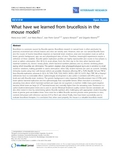Mostrar el registro sencillo del ítem
What have we learned from brucellosis in the mouse model?
| dc.creator | Grilló Dolset, María Jesús | es_ES |
| dc.creator | Blasco, José María | es_ES |
| dc.creator | Gorvel, Jean-Pierre | es_ES |
| dc.creator | Moriyón Uría, Ignacio | es_ES |
| dc.creator | Moreno, Edgardo | es_ES |
| dc.date.accessioned | 2014-06-20T06:37:04Z | |
| dc.date.available | 2014-06-20T06:37:04Z | |
| dc.date.issued | 2012 | |
| dc.identifier.issn | 1297-9716 (electronic) | |
| dc.identifier.issn | 0928-4249 (print) | |
| dc.identifier.other | 1069 | |
| dc.identifier.uri | https://hdl.handle.net/2454/10923 | |
| dc.description.abstract | Brucellosis is a zoonosis caused by Brucella species. Brucellosis research in natural hosts is often precluded by practical, economical and ethical reasons and mice are widely used. However, mice are not natural Brucella hosts and the course of murine brucellosis depends on bacterial strain virulence, dose and inoculation route as well as breed, genetic background, age, sex and physiological statu of mice. Therefore, meaningful experiments require a definition of these variables. Brucella spleen replication profiles are highly reproducible and course in four phases: i), onset or spleen colonization (first 48h); ii), acute phase, from the third day to the time when bacteria reach maximal numbers; iii), chronic steady phase, where bacterial numbers plateaus; and iv), chronic declining phase, during which brucellae are eliminated. This pattern displays clear physiopathological signs and is sensitive to small virulence variations, making possible to assess attenuation when fully virulent bacteria are used as controls. Similarly, immunity studies using mice with known defects are possible. Mutations affecting INF-gamma, TLR9, Myd88, Tgammadelta and TNF-beta favor Brucella replication; whereas IL-1beta, IL-18, TLR4, TLR5, TLR2, NOD1, NOD2, GM-CSF, IL/17r, Rip2, TRIF, NK or Nramp1 deficiencies have no noticeable effects. Splenomegaly development is also useful: it correlates with IFN-gamma and IL-12 levels and with Brucella strain virulence. The genetic background is also important: Brucella-resistant mice (C57BL) yield lower splenic bacterial replication and less splenomegaly than susceptible breeds. When inoculum is increased, a saturating dose above which bacterial numbers per organ do not augment, is reached. Unlike many gram-negative bacteria, lethal doses are large (greater than or equal to] 108 bacteria/mouse) and normally higher than the saturating dose. Persistence is a useful virulence/attenuation index and is used in vaccine (Residual Virulence) quality control. Vaccine candidates are also often tested in mice by determining splenic Brucella numbers after challenging with appropriate virulent brucellae doses at precise post-vaccination times. Since most live or killed Brucella vaccines provide some protection in mice, controls immunized with reference vaccines (S19 or Rev1) are critical. Finally, mice have been successfully used to evaluate brucellosis therapies. It is concluded that, when used properly, the mouse is a valuable brucellosis model. | en |
| dc.description.sponsorship | This work was performed under agreement contract 2010020113, subscribed by UNA from Costa Rica and, CSIC, CITA, and UN from Spain. This work was funded by grants FIDA-2009 UNA, FS-CONARE UNA/UCR, NeTropica 8, and MICIT/CONICIT, CSIC-CRUSA (2010CR0005) from Costa Rica; and CICYT-MICINN (AGL2010-20247, AGL2008-04514-C03-00 and AGL2011-30453-C04-00) projects from Spain and grant ANR2010BLAN1308 Brutir., form France. This work was done as part of the UCR/DAAD Humboldt Fellow award 2012 to EM. | en |
| dc.format.mimetype | application/pdf | en |
| dc.language.iso | eng | en |
| dc.publisher | BioMed Central | en |
| dc.relation.ispartof | Veterinary Research, 2012, 43:29 | en |
| dc.rights | © 2012 Grillo et al.; licensee BioMed Central Ltd. This is an Open Access article distributed under the terms of the Creative Commons Attribution License (http://creativecommons.org/licenses/by/2.0), which permits unrestricted use, distribution, and reproduction in any medium, provided the original work is properly cited. | en |
| dc.rights.uri | http://creativecommons.org/licenses/by/2.0/ | |
| dc.subject | Brucellosis | en |
| dc.subject | Mice | en |
| dc.title | What have we learned from brucellosis in the mouse model? | en |
| dc.type | Artículo / Artikulua | es |
| dc.type | info:eu-repo/semantics/article | en |
| dc.contributor.department | IdAB. Instituto de Agrobiotecnología / Agrobioteknologiako Institutua | es |
| dc.rights.accessRights | Acceso abierto / Sarbide irekia | es |
| dc.rights.accessRights | info:eu-repo/semantics/openAccess | en |
| dc.identifier.doi | 10.1186/1297-9716-43-29 | |
| dc.relation.projectID | info:eu-repo/grantAgreement/MICINN//AGL2010-20247/ES/ | en |
| dc.relation.projectID | info:eu-repo/grantAgreement/MICINN//AGL2008-04514-C03-01/ES/ | en |
| dc.relation.projectID | info:eu-repo/grantAgreement/MICINN//AGL2011-30453-C04-03/ES/ | en |
| dc.relation.publisherversion | https://dx.doi.org/10.1186/1297-9716-43-29 | |
| dc.type.version | Versión publicada / Argitaratu den bertsioa | es |
| dc.type.version | info:eu-repo/semantics/publishedVersion | en |
Ficheros en el ítem
Este ítem aparece en la(s) siguiente(s) colección(ones)
La licencia del ítem se describe como © 2012 Grillo et al.; licensee BioMed Central Ltd. This is an Open Access article distributed under the terms of the Creative
Commons Attribution License (http://creativecommons.org/licenses/by/2.0), which permits unrestricted use, distribution, and
reproduction in any medium, provided the original work is properly cited.



